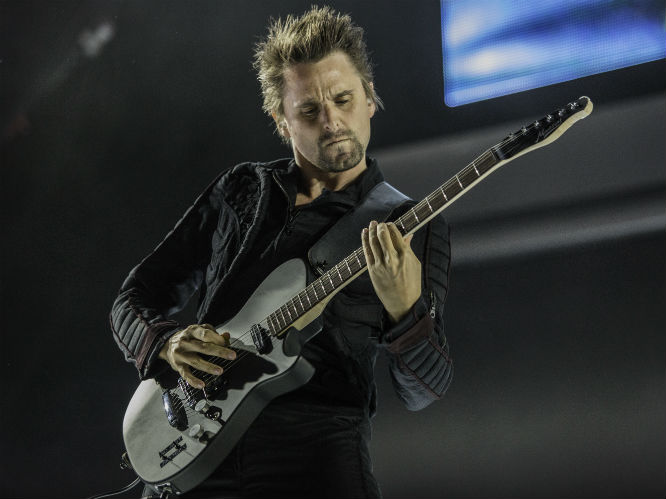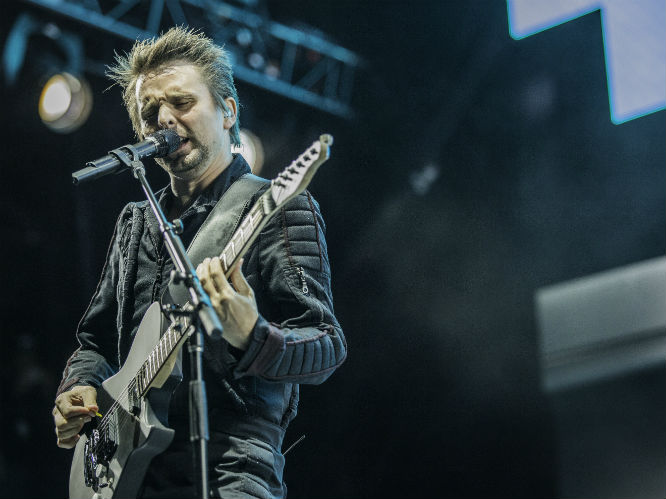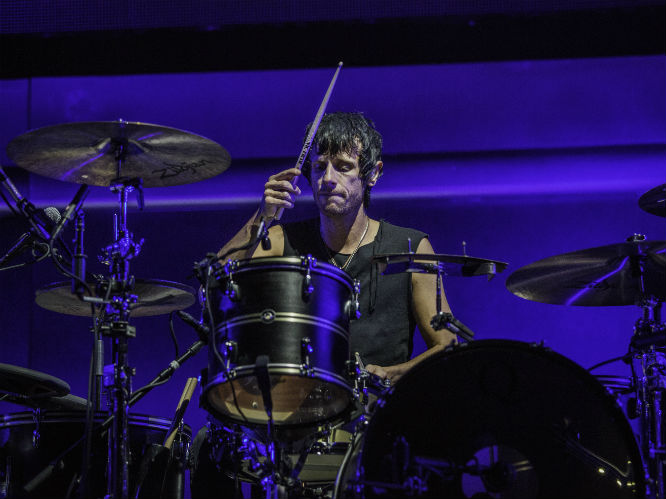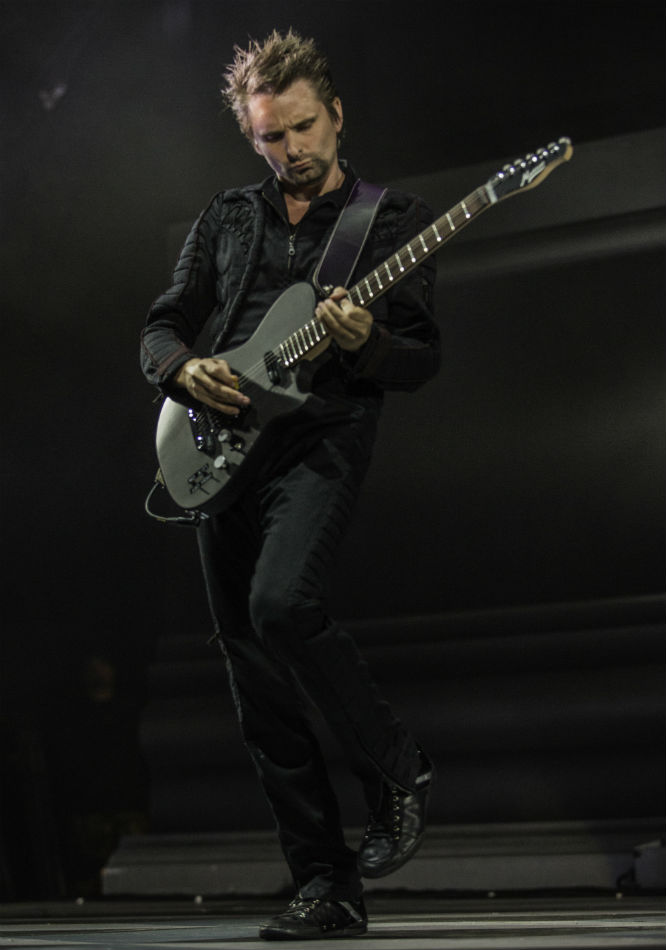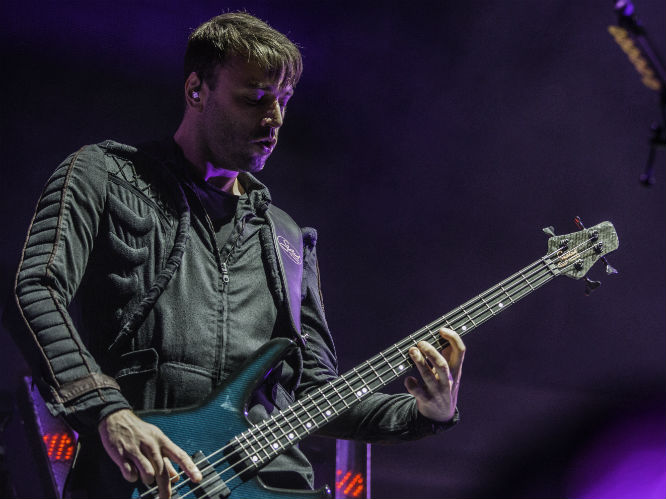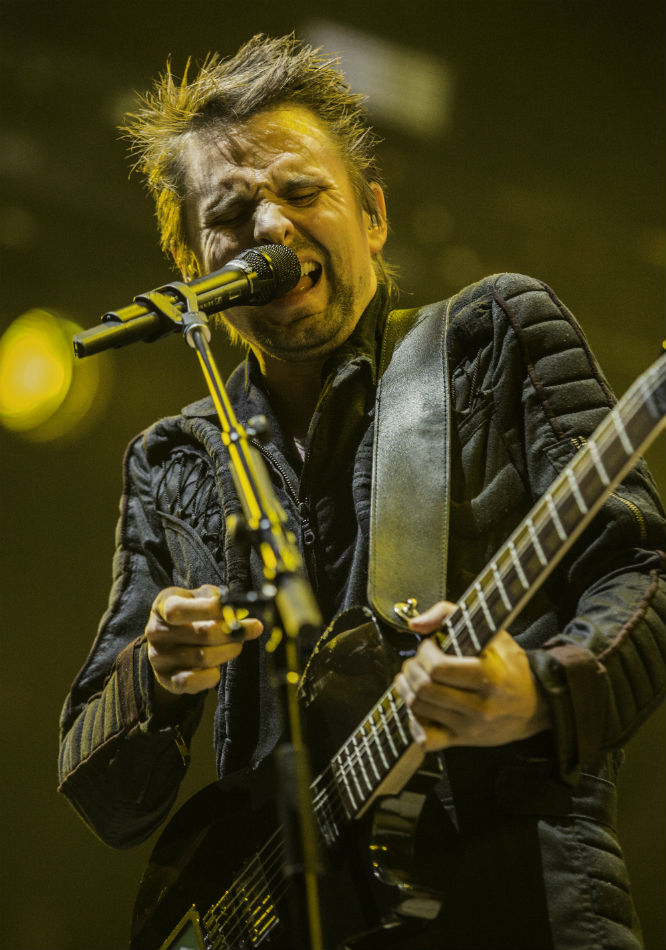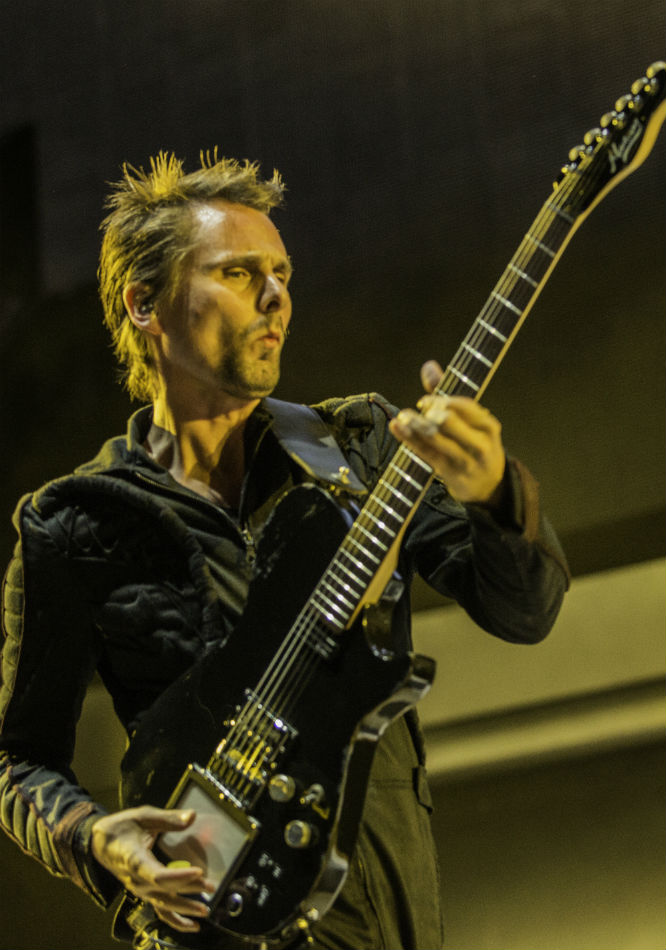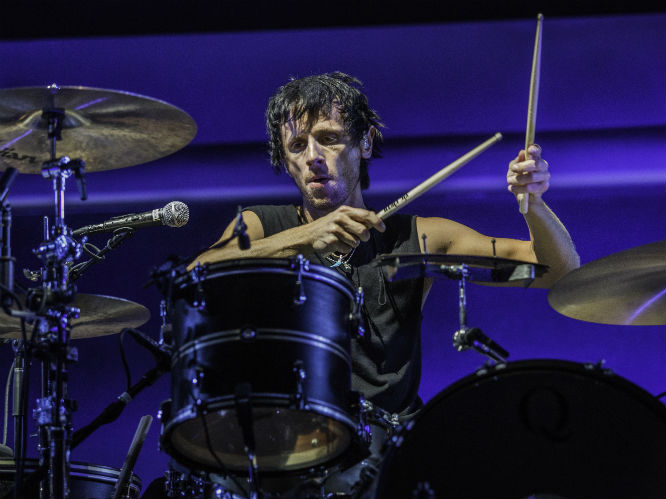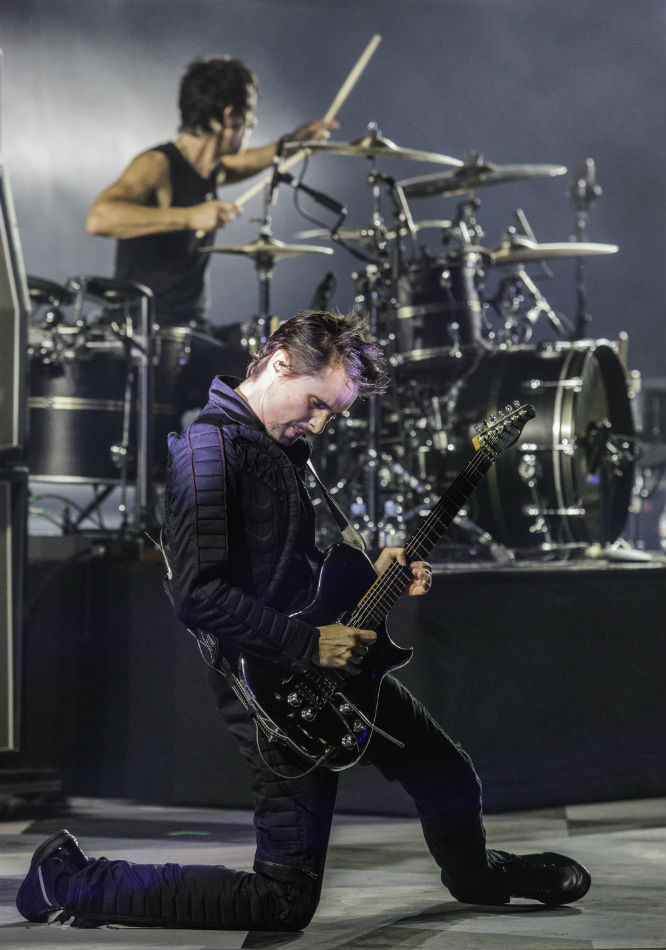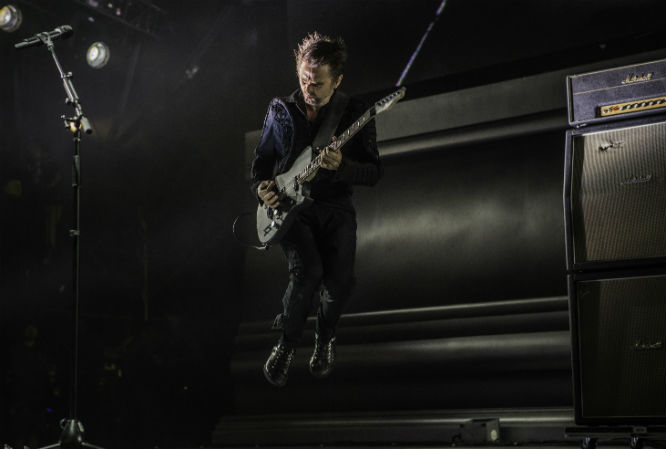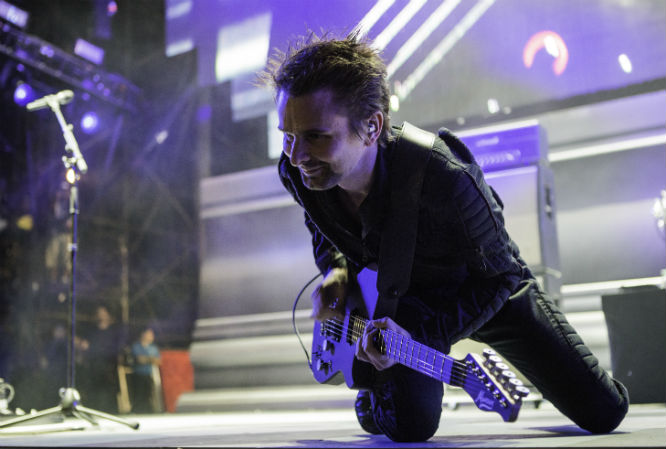More about: Muse
Without question the biggest rock record of the summer, Muse's Drones has been hovering into view for some time now.
Frontman Matt Bellamy has been discussing the inspiration behind the band's remarkable seventh album - including the fact he had studied Richard Whittle's book Predator: The Secret Origins of The Drone Revolution.
As such, Gigwise got in touch with Whittle, a military expert and a Global Fellow at the Woodrow Wilson International Center for Scholars in Washington. We discussed his thoughts on Bellamy's drone prophecies, the potential for drone technology and Whittle's own extraordinary rock history.
Gigwise: Could you give us your impression of both Muse's 'Mercy' and the video for 'Dead Inside'?
Richard Whittle: I’m absolutely wowed by 'Mercy', 'Dead Inside' and by 'Psycho' too. All three are brilliant and while my view of drone technology is a lot less dark than Matt Bellamy’s, his lyrics force you to think about the implications of drones, and that’s something we all need to do. The video with 'Dead Inside' is just stunning, beautifully done, and full of visual metaphors that evoke drone warfare and add power to Matt’s message.
Matt Bellamy said of his new album: "To me, 'Drones' are metaphorical psychopaths which enable psychopathic behaviour with no recourse. The world is run by Drones utilizing Drones to turn us all into Drones." Would your investigations into drone technology back that up?
Artists like Matt Bellamy look at the world through their own prisms and interpret what they see in ways that escape the rest of us until they bring them to our attention. I get what Matt is saying, but he’s using the word “drones” as a metaphor for a mentality, not just an aircraft with no pilot inside.
As an author and journalist, I take a different approach than an artist or an activist does. I didn’t write Predator: The Secret Origins of the Drone Revolution to express a view but to understand how the drone revolution began so I could understand where it’s taking us. Drones have already changed the way we die, the question now is how they’re going to change the way we live.
Drones are a revolutionary and a dangerous technology – not just because they’ve been used in targeted killings but because even unarmed civilian drones just carrying cameras can pose a hazard to air safety and a threat to personal privacy. Terrorists might make use of drones, too.
But drones are just a technology, and they come in a huge and increasing number of varieties. Drones don’t have to be used to kill, they can also do a tremendous amount of good, from helping find lost children to showing rescuers in natural or manmade disasters where victims are to delivering medicine to isolated communities to you name it. The good things drones can do are limited only by our imaginations.
But drones are new and they’re a technological tsunami that can do us a lot of harm if we don’t pay attention and protect ourselves from their dangers and risks. When the automobile came along, we needed traffic laws and signs and stoplights to govern that new technology. We don’t have all the laws we need for drones yet, and we need to get this new technology and how it’s used under control.
Targeted killing is just the most dramatic example of that. The availability of a weapon whose operators can stalk and kill a single individual on the other side of the planet from a position of ambush and total invulnerability has led the CIA and President Obama to rely heavily on drone strikes to deal with terrorism – a policy the people who armed the Predator and advocated using it to kill Osama bin Laden before 9/11 didn’t imagine.
A couple of years ago, when he was running the CIA, Leon Panetta called drone strikes “the only game in town” in the war with Al Qaeda. Very few Americans have questioned the wisdom of relying on what could also be called a policy of assassination, and there’s a real Minority Report aspect to how that policy has been carried out under Obama. Those targeted aren’t necessarily killed because of what they’ve done but because of what the people deciding to kill them think they’re going to do. We need to protect ourselves from terrorists, but we also need to protect justice and democracy. So, however metaphorical, we need wakeup calls like Muse’s Drones. Besides, it’s terrific music.

In his NME interview Matt says you revealed drone strikes have been launched by operators using a trailer hidden on the parking lot at CIA headquarters. How did you discover this and is he right saying the military are “essentially playing video games all day with real lives”?
The fact that Predator strikes were conducted from the CIA campus was revealed, at least to me, by Gen. Tommy Franks, the supreme U.S. commander of the war in Afghanistan, in his memoir. When I started this book, I wasn’t sure I’d be able to find out much more than that, but I set out to interview every person I could find, in uniform or out, who had had anything to do with the Predator.
The more Air Force people I interviewed, the more I heard that I really had to talk to a civilian at the Pentagon, a former Air Force colonel nicknamed “Snake.” So I found Snake Clark, a key figure at several points in the history of the Predator, and he explained that the Predator had been turned into a world-changing weapon by an Air Force organization called “Big Safari” – a unit with such a low profile that I had never heard of it in three decades of writing about the military. Once I knew where to look, I was able to find and interview members of a small Air Force team that included Big Safari operators who used an unarmed Predator to find Osama bin Laden in Afghanistan in 2000.
Big Safari then armed the Predator and rigged it for global remote control while higher-ups considered whether to use it to kill Bin Laden before 9/11. Members of that Air Force cadre were assigned to sit on the CIA campus in ground control stations disguised to look like construction storage containers and from there fly Predators with Hellfire missiles over Afghanistan. I was able to interview a number of them about how the first drone strikes came about, some of which I describe in detail in my book.
From the interviews I did, I don’t think most of them felt they were playing video games, though of course the analogy is inevitable. The officer who pulled the trigger on the first drone strike, Capt. Scott Swanson, has written about this very point for the web site Breaking Defense.
Matt told Radio One's Annie Mac about how "through modern technology, and obviously through drone warfare in particular, it’s possible to actually do quite horrific things by remote control, at a great distance, without actually feeling any of the consequences, or even feeling responsible in some way." Does that meet with your findings - that individuals are able to make difficult decisions because they feel disconnected?
Logical as that sounds, I think that aspect of drone warfare really applies more to those in command, who may be tempted to use drone strikes because they can take action without risking any troops. The drone operators I’ve talked to have actually had quite the opposite reaction. They spend so much time studying their targets through a camera lens that they can come to feel they personally know them.
Another Air Force officer in my book, a woman who had been a fighter-bomber pilot before she got assigned against her wishes to fly the Predator, found it more difficult emotionally to fire missiles at people from a drone than to drop bombs over Kosovo from an aircraft she was inside. She knew she was killing people when she dropped bombs from her F-15E, too, but flying high and fast, it was rare to see those people. She saw her strikes only in brief glimpses of infrared video from a targeting pod, and after dropping her bombs, she flew away. With the Predator, she might watch people for hours before launching a Hellfire at them or helping other aircraft find and attack them. She might see their bodies blow apart, and then be ordered to keep the drone circling to see the result of the strike.
Anne Hathaway is currently starring in a play called Grounded about a fictional woman drone pilot that addresses this aspect of drone warfare very powerfully. A number of Predator and Reaper pilots and also sensor operators, who see a lot of disturbing images because their job is to keep a laser beam on the target until the missile or bomb hits, have been found to suffer post-traumatic stress disorder. Others just feel guilty. One commander I know asked his squadron’s chaplain to sit in the Predator crew break room to talk to them after their missions and try to help them deal with the emotional aspect of what they do. It’s important to understand that it isn’t the pilot and sensor operator who pick the targets or decide when to shoot. That’s all done at a higher level in the chain of command.

Matt also said that "The next step in drones is gonna be autonomous drones, which actually make ‘kill’ decisions themselves, where no humans are involved." How far is that off - it is a matter of years or months?
On this one, Matt is absolutely spot on, especially when he said in the NME interview that, “The whole thing’s quite frightening, and I don’t think the public are really as aware as they should be of where this is all going, what it means.” I attended a conference recently where military and Pentagon officials discussed in great detail where drones are going and what they want from them, and more autonomy is number one on the list. One slide I’ve seen predicts that at the rate artificial intelligence is developing, totally autonomous unmanned aerial systems will be available by 2020 – five years from now.
The good news, though, is that many military people are just as wary as Matt is of letting machines make “kill” decisions. In fact, three years ago our Defense Department put into place a directive that says, “Autonomous and semi-autonomous weapon systems shall be designed to allow commanders and operators to exercise appropriate levels of human judgment over the use of force.” In other words, there’s a regulation against letting drones make “kill” decisions all by themselves. Of course, that only applies to the U.S. military, and directives can be rescinded.
Do you think that what many people would consider conspiracy theories about the military are now proven to be commonplace?
As a general rule, I’m skeptical of conspiracy theories, because in Washington, at least, nothing much stays secret after a third person learns it. But conspiracies do exist and succeed, as Al Qaeda so painfully proved to us on Sept. 11, 2001.
What particularly shocked you during your five years of research for the book?
When I realised that it wasn’t the usual suspects in the military-industrial complex that created the modern drone. The Predator, which is the drone that sparked the revolution, was invented and turned into a world-changing weapon by a series of iconoclasts the military and industry initially resisted. They include a genius former Israeli aeronautical engineer who turned his Los Angeles garage into a drone lab and a pair of billionaire brothers who wanted to use automated drones to help the Contra rebels overthrow the Sandinistas in Nicaragua.
They also include a techno-scientist Snake Clark calls "The Man With Two Brains", but whom by mutual agreement I call “Werner” in the book, who devised the system of global remote control to let the CIA use an armed Predator to try to kill Osama bin Laden in Afghanistan with the drone operators in the U.S. instead of a ground control station at Ramstein Air Base in Germany. The drone revolution came about because, as I say in the book, necessity is the mother of invention but war is the mother of necessity.

Is there another drone book or film you would recommend Matt check out having read yours?
One of the most impressively researched ones I’ve seen on the issue of targeted killings is Sudden Justice by Chris Woods, which Oxford University Press published 13 May. So far as I know, there isn’t yet a good book that examines the whole range of issues raised by the drone revolution and drone proliferation. But I hope to remedy that.
Have you previously seen any other interesting juxtapositions between drones and music?
Indeed, though from a source you might not imagine. After the Air Force team at the CIA began using the armed Predator in the war in Afghanistan, they put together a video to show at a retirement party for the director of Big Safari. This was in late 2002, Osama bin Laden was still alive, and members of the Predator team were still dearly hoping to kill him. So for background music, they used Blondie’s “One Way Or Another.”
What music do you personally enjoy and what was the last gig you went to?
My taste in music is fairly eclectic. I regularly listen to classical, pop, blue grass, Gaelic, medieval, and a smidgen of jazz. I love almost every song Cesaria Evora and Patricia Kaas have ever done. But when it comes to rock, I’m largely mired in the Sixties and Seventies. I still often listen to the Stones, Jethro Tull, Jimi Hendrix, and Jefferson Airplane.
Pink Floyd’s The Wall is one of my favorites. I’ve even imagined phrases from 'Another Brick In The Wall' and 'Comfortably Numb' as background music for certain scenes when I picture the CIA operation revealed in my book as a movie. Now, though, I’d have to urge the movie director to include cuts from Muse’s Drones.
The last gig I went to? Keep in mind that you’re talking to a guy who saw the Beatles live on The Ed Sullivan Show in 1964. I can still hear my dear departed Mom saying, “Good grief, look at their hair – they look like girls!” The last live gig I went to was a Stones concert in Greensboro, North Carolina. The date was June 26, 1978.

Predator: The Secret Origins Of The Drone Revolution is out now. For more information please visit richardwhittle.net. Muse's Drones is released on 8 June.
More about: Muse




